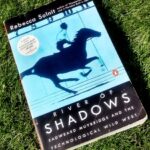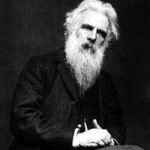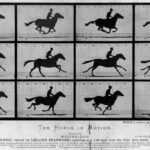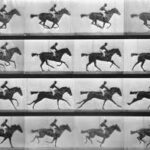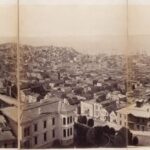River of Shadows – Rebecca Solnit
I’ve been meaning to post this on my blog for a little while. Some thoughts on a book I received as a present last year. It turned out to be a real gift. Rebecca Solnit’s book River of Shadows – Edweard Muybridge and the Technological Wild West is a marvellous meditation on the transformation of time and space, through ‘the annihilation of time’. This was the popular phrase coined in the nineteenth century to describe the revolution taking place in transport, the bridging of America by the steam-train – and the huge breakthrough in photographic chemistry that allowed for the fixing of images on glass plate. Edweard Muybridge’s work in pioneering photography is key to the sense of the world changing at that time.
Science, Time and Motion Studies
She examines the central role as played by the ever accelerating science of photography, as it developed through the period, as advanced through the central character, Eadweard Muybridge. Muybridge’s vision of the possibilities of photography is what makes him such an important name in the canon of great innovators in this area, and cements his name in visual history. His motion studies are what he is most acclaimed for, which were a scientific examination of bodies moving across a linear system of large plate cameras (the cutting edge of technology at the time), but these have segued into the realm of beautiful early photographic art. His work was supported by Leland Standford, a railroad man who freed up Muybridge from regular commercial photography. Like Muybridge’s animals in motion studies, River of Shadows is a perfect dissection of a moment, coming into and disappearing out of view. The modern era of trains, photography, cinema, the ‘annihilation of space and time’ the old world slipping away are central to the currency of Solnit’s book. She writes in lines and circles, digging out tracks of time, cause and effect, but always bringing the narrative back to key events and encounters; Muybridge the journeyman innovator, artist, chameleon and murderer. (He was tried and acquitted on grounds of justifiable homicide of killing his wife’s lover, the rather caddish interloper Major Harry Larkyns.) Muybridge commissioned the first fast reliable shutter for a camera, a key innovation for the future of photography. He also pioneered the zoopraxiscope, a device like the zoetrope that allowed people to view the earliest ‘movies’.
Stanford University
The birth of Stanford University, the death of Sitting Bull, the Madoc Civilisation and the growth of San Francisco are all central themes, as are the rise and fall of the railroads and Silicon valley. Solnit’s River of Shadows the kind of book so good you don’t want to turn the last page and finally put it down. http://www.friscovista.com/news/category/history/ http://www.eadweardmuybridge.co.uk/ http://gawainweaver.com/news/News-1878-Muybridge-San-Francisco-Panorama-Conserved/ http://www.sfmoma.org/about/press/press_exhibitions/releases/864

